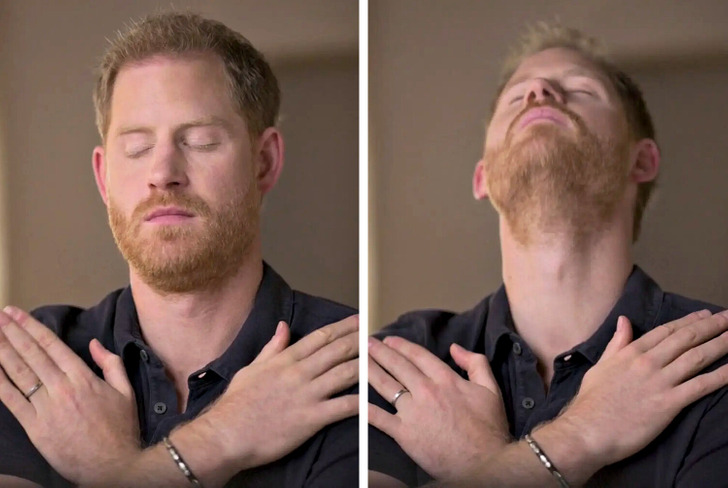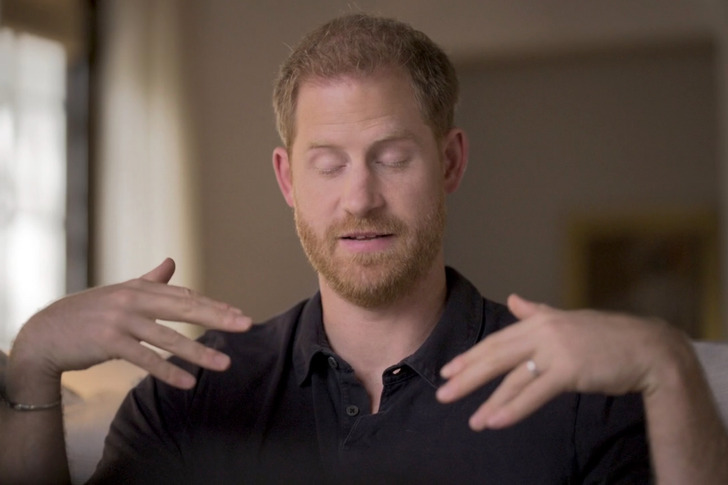Prince Harry recently opened up about his journey with post-traumatic stress disorder following the loss of his mother, Princess Diana. In a candid discussion, he revealed his exploration of a groundbreaking therapy that helped him.

The therapy is called eye movement desensitization and reprocessing (EMDR) to address the debilitating effects of his anxiety attacks. This revelation offers a glimpse into the royal’s personal struggles and his proactive approach towards mental health care, shedding light on the significance of seeking innovative treatments of traumas.
In a video, Prince Harry can be seen undergoing EMDR therapy, where he taps his shoulders and moves his eyes rapidly. This therapy is relatively new and is used to treat PTSD. Prince Harry shared that he decided to try EMDR to deal with severe anxiety attacks he was experiencing.
Prince Harry mentioned that he was open to trying EMDR because of the therapy and work he had done over the years.

During a therapy session with UK-based psychotherapist Sanja Oakley, Prince Harry demonstrated how EMDR helped him feel better about returning home. He described feeling scared and helpless before, but the therapy helped him cope with those feelings.
Prince Harry’s openness about his experience with EMDR therapy sheds light on alternative treatments for post-traumatic disorder and mental health struggles. It shows that seeking help and trying different therapies can make a difference in managing mental health conditions.

EMDR is a therapy made in 1987 to help with emotional traumas. It’s a structured therapy where you think about a tough memory while moving your eyes back and forth. This helps lessen the strong feelings tied to the memory.
EMDR works on a theory called Adaptive Information Processing (AIP). It says that trauma sticks around because it hasn’t been dealt with properly. So, when something reminds you of the trauma, those memories can come back strongly.
Unlike other therapies that try to lessen your reaction to trauma, EMDR tries to change how your brain stores those tough memories. Sometimes, instead of eye movements, you might listen to alternating tones. Usually, EMDR happens once or twice a week for about six to 12 sessions. But it can vary depending on the person.
Benefits of EMDR therapy
- EMDR is a structured therapy and usually needs fewer sessions than ongoing therapies.
- You don’t have to keep going back to the tough memory for a long time.
- You don’t have to talk a lot about what happened to you.
- There’s no homework to do.
- EMDR doesn’t try to change your thoughts and beliefs.
Disadvantages of EMDR therapy
- While EMDR is known to help with PTSD, it hasn’t been studied as much for other mood or mental health problems.
- If you’re avoiding talking about a tough event, EMDR might not be the best choice. Other types of talk therapy might work better.
- EMDR can sometimes make you feel worse at the start of treatment. The person who created EMDR warns that this could be dangerous for people who have gone through really tough things.
The process of EMDR
EMDR is a structured process with eight phases, each aimed at helping you deal with traumatic memories:
- History taking: Discuss your past with the therapist to identify which memories to focus on.
- Preparation: Learn about EMDR and how the therapist will use bilateral stimulation.
- Assessment: Identify your negative and positive beliefs related to the trauma.
- Desensitization: Use bilateral stimulation while recalling the memory.
- Installation: Focus on positive beliefs while processing the memory.
- Body scan: Talk about how you feel emotionally and physically.
- Closure: Prepare for what may happen between sessions.
- Reevaluation: Assess your progress and decide if more sessions are needed.
As you go through EMDR, you may start feeling less overwhelmed by the trauma. It’s normal for other painful memories to surface, indicating that suppressed memories are being processed.
When grappling with deep emotional traumas, it’s crucial to seek out specialists who can provide the appropriate form of treatment tailored to your needs. Whether it’s EMDR therapy or other therapeutic approaches, finding the right professional can make a significant difference in your healing journey.
Preview photo credit Good Morning America / YouTube
Viewers demand ‘jail time’ after streamer crashes McLaren whilst filming leaving his friend bleeding inside

The content creator was streaming at the time of the crash
observers have been left affrighted and demanding’ jail time’ after watching footage of banderole
and influencer Jack Doherty crashing his McLaren.
The 20- time-old YouTuber and happy creator has made captions after footage surfaced of him crashing his high- powered McLaren supercar into the rail on a binary expressway.
It would appear that Doherty had been live- streaming on Kick at the time of the crash, with footage from the incident latterly appearing online.
In the vids which have been participated on X- the content creator appears to be driving down a trace in heavy rain while putatively detracted by his phone. It’s unclear what exactly causes Doherty to lose control of his vehicle, as he begins to swerve to the right and smashes into the rail.
The videotape also cuts to the fate of the crash, where a shocked Doherty can be seen standing outside the auto blurting ‘ Holy s ** t’ before turning the camera towards his cameraman Michael, who’s bleeding from the face, and asking” Are you okay?”
” Oh my god bro, my whole f**king auto bro,” he adds, showing the auto rammed under the hedge with corridor of the bonnet bestrew across the road. He also hands the phone to his injured friend and asks him to continue recording.
Another videotape depicts the moment bystanders pulled Doherty and his friend from the auto.

substantiations saved the content creator and his friend from the auto while they continue rephotographing, with Doherty heard saying” My f**king auto, holy s ** t no.”
Doherty latterly participated updates on the fate of the crash on his social media accounts, attesting that both he and his cameraman Michael were n’t seriously injured in the incident, still, Michael did bear aches to his face.
The videotape creator has also posted an update on his own account, thanking everyone who reached out to check if he was okay after seeing the videotape.
While Doherty’s followers were relieved to see that he and Michael were safe a lot of people online were n’t impressed by the videotape and have called for the content creator to face impacts for his conduct.

” License suspended, jail time,” one person wrote on X.” This is well proved reckless driving. At a minimum he should be banned on all platforms for this.”
” reckless driving,” a alternate person reflected, while a fourth added” So your telling me he started recording the moment the crash happed yeah wtf.”
It would also appear that Doherty’s Kick channel has been removed in the wake of the incident, with a link to his runner now coming up with an error communication.
It’s unclear where exactly Doherty had crashed, a road sign spotted in his videotape suggests he was in Florida, still, it’s worth noting that all of the US countries( with the exception of Montana) have restrictions on using your phone while driving.



Leave a Reply